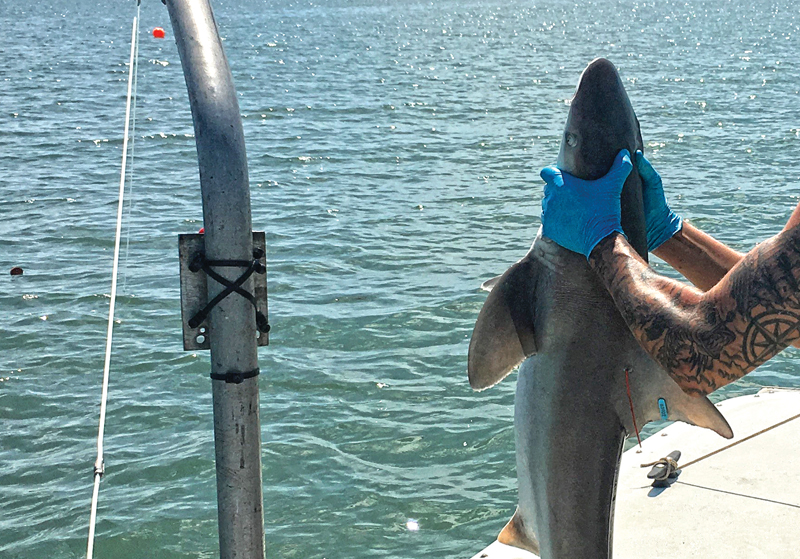Will you need a bigger boat? What you need to know about sharks in the Chesapeake.
Have you seen a dorsal fin slice the surface of the Chesapeake Bay and wondered if you need a bigger boat? Just because you’re not in the ocean doesn’t mean you’re not in shark territory—specifically the sandbar shark, bull shark, sand tiger shark, smooth dogfish, and spiny dogfish. Those are the most common sharks in the Bay, according to the Chesapeake Bay Foundation (CBF). Rare visitors include the basking shark, bonnethead, smooth hammerhead, Atlantic angel shark, the scalloped hammerhead, the dusky shark, and the Atlantic sharpnose.

1. The sandbar shark
The sandbar shark inhabits the Atlantic from Massachusetts to southern Brazil, visiting the Chesapeake from spring to fall. The Bay is one of the most important nursery areas on the East Coast for young sandbar sharks, according to the Chesapeake Bay Program (CBP).
Dr. Robert J. Latour, Professor of Marine Science at the Virginia Institute of Marine Science (VIMS) at William and Mary, told SpinSheet, “In the spring (late May and early June), pregnant sandbar sharks migrate into the Bay to birth their pups. These sharks leave the estuary and migrate northward, while the neonates remain throughout the summer, using the Bay as a nursery area. The neonate sharks migrate south of Cape Hatteras in the fall to overwinter. Juvenile sandbar sharks (those aged one to about seven) will return to the Bay each spring.”
Concerned? These babies aren’t interested in you. They eat bottom fish, other sharks, rays, and invertebrates, but they are your competition. Sandbar sharks are known for their love of blue crabs, so if you run into one, pass the Old Bay.
2. The bull shark
Bull sharks are not common in the Chesapeake Bay, but they have been recorded as far north as the Patuxent River. According to CBP, they eat bony fish, rays, and other sharks (particularly juvenile sandbar sharks), crustaceans, turtles, and mammals. They have a reputation for being aggressive, but “Bull sharks are likely no more aggressive than other large sharks such as white or tiger sharks,” Latour said.
“Because this species can inhabit relatively shallow fresh and saltwater habitats, humans are more apt to encounter a bull shark than a white or tiger, leading to this undeserved reputation for being overly aggressive. Bull sharks are usually uninterested in humans, since we are not their natural prey.”
3. The sand tiger shark
In summer and fall, sand tiger sharks swim up the Lower Bay. They’re nocturnal and eat small fish, squid, and other sharks, according to CBF. Sand tigers can look intimidating at up to 10 feet long. but there have been no recorded attacks on humans.
4. The dogfish shark
The smooth dogfish inhabits the Lower Bay, seen up to the Patuxent, in less than 60 feet of water. It’s a bottom feeder and swims in schools.
5. The spiny dogfish shark
From late fall through early spring, the spiny dogfish haunts the Southern Bay. It also travels in schools but prefers deeper water.
The Bay’s shark populations are increasing.
That’s good news. A study published by former VIMS doctoral student Cassidy Peterson and Dr. Latour in 2017 found that shark populations in the southeastern United States appear to be recovering from overfishing, and that this recovery began in the middle to late 2000s.
Latour explained, “The increasing presence of sharks would be a sign of a healthy Bay. Most sharks are apex predators, meaning they are positioned near the top of the marine food web. As such, they play an important ecological role by regulating prey populations and providing balance to the ecosystem. Robust shark populations promote biodiversity which is vital to ecosystem health.”
The bad news according to Dr. Latour: shark populations along the US Atlantic Coast are shifting northward and toward deeper waters in response to climate change. The amount of suitable habitat for sharks is declining, particularly during fall months.
“The impact of climate change on shark population sizes depends on a myriad of factors and requires additional research,” he said.
Basic shark safety
On the slim chance that you do run into a shark in the Bay, basic shark safety dictates:
- Swim between 9 a.m. and 5 p.m.
- Remove jewelry and other shiny accessories.
- Avoid murky or cloudy waters.
- Refrain from swimming alone.
- Remain relatively close to the shore.
- Avoid swimming near fishing activities (e.g. fishing piers, surf casting, seine operations).
- Be aware when fishing with chum and larger natural baits.
- Maintain an awareness of your surroundings.
If you are in the water and see a shark, work toward getting out of the water as soon as possible, but do not turn your back and swim. Most of the sharks inhabiting Chesapeake Bay are immature (neonate and juvenile) sandbar sharks, which pose little to no threat to humans.
by Maria Bellos Fisher




